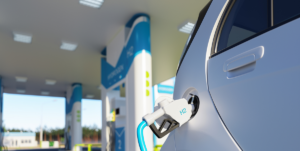As the world becomes more conscious of the impact of climate change, there is an increasing demand for sustainable and eco-friendly alternatives to traditional fuel-powered vehicles. Hydrogen-fuelled cars have emerged as a promising option that could help reduce our carbon footprint while providing an efficient and cost-effective mode of transportation. In this article, we’ll explore the benefits of hydrogen-fuelled cars, their potential impact on the environment, the challenges facing their adoption and a breakdown of other alternative fuel sources.
What are Hydrogen Fuelled Cars?
Hydrogen fuelled cars are vehicles that use hydrogen gas as their primary fuel source. These cars are powered by a fuel cell, which converts hydrogen into electricity that drives the car’s electric motor. Unlike fuel-powered cars, which emit harmful pollutants, hydrogen-fuelled cars only produce water vapour and heat as by-products.
Benefits of Hydrogen-Fuelled Cars
1. Zero Emissions
Hydrogen-fuelled cars are emission-free. This makes hydrogen cars an excellent option for reducing our carbon footprint and improving air quality.
2. Efficiency
Hydrogen cars are more efficient than traditional fuel-powered cars. They convert more of the energy from the fuel into motion, which means they use less fuel and travel farther on a full tank.
3. Quick Refuelling
Hydrogen cars can be refuelled in a matter of minutes, just like traditional fuel-powered cars. This is in contrast to electric cars, which take several hours to recharge.
4. Cost-Effective
Hydrogen fuel is relatively cheap and abundant. In addition, the efficiency of hydrogen-fuelled cars means that you’ll spend less on fuel compared to fuel-powered cars. Much like electric cars, hydrogen vehicles are also road tax-free.
Potential Impact on the Environment
Hydrogen cars have the potential to significantly reduce our carbon footprint. The only by-products produced by these cars are water vapour and heat, which means they don’t contribute to greenhouse gas emissions. In addition, the production of hydrogen fuel can be done using renewable energy sources such as wind or solar power, further reducing our reliance on fossil fuels.
Challenges Facing Adoption
Despite the numerous benefits of hydrogen cars, there are still several challenges facing their market growth. The first challenge is the lack of infrastructure. There are currently only a few refuelling stations for hydrogen-fuelled cars in most countries. This limits the range of these cars and makes them less practical for long-distance travel. Whilst the UK is seeing a steady increase in the number of EV charging stations, but still not enough to reach the government’s ‘electric by 2030’ initiative, it’s safe to assume that creating the necessary infrastructure for hydrogen powered transport will take a while longer…
Another challenge is the cost of production. While the cost of hydrogen fuel is relatively cheap, the cost of producing fuel cells is still high. This makes the cars themselves more expensive than traditional fossil fuel-powered cars.
There is also the issue of safety. Hydrogen gas is highly flammable, and there are concerns about the safety of storing and transporting large quantities of the gas.
Overall, hydrogen cars have the potential to revolutionize the way we travel and reduce our impact on the environment. These cars are emission-free, efficient, quick to refuel, and cost-effective. However, their adoption still faces several challenges, including the lack of infrastructure, high production costs, and safety concerns. Nevertheless, as the world becomes more conscious of the need to reduce our carbon footprint, hydrogen-fuelled cars are likely to play an increasingly important role in the future of green transportation.
What does the market look like for used Hydrogen cars?
As hydrogen-fuelled cars are still a relatively new technology, there is currently a limited market for used hydrogen-fuelled cars. However, as the technology becomes more established and the market for new hydrogen-fuelled cars grows, it is possible that a market for used hydrogen-fuelled cars may emerge.
One factor that could influence the growth of the used hydrogen-fuelled car market is the durability of the fuel cell technology. Unlike traditional gasoline-powered cars, which have well-established maintenance and repair industries, hydrogen-fuelled cars require specialized maintenance and repair services, which may limit their resale value.
Another factor that could impact the used hydrogen-fuelled car market is the availability of hydrogen fuel infrastructure. If the infrastructure for hydrogen fuel continues to expand, and the cost of producing and distributing hydrogen fuel decreases, it could make used hydrogen-fuelled cars more attractive to buyers.
Overall, the growth of this market will depend on a variety of factors, including the durability of the fuel cell technology and the availability of hydrogen fuel infrastructure. But how soon that will be, no one can say, but It’s pretty safe to say that this is a consideration for far into the future.
What are other car alternative fuel sources other than electricity?
1. Biofuel
Biodiesel is manufactured from vegetable oils and animal fats, whereas bioethanol (a form of biodiesel) is made from corn and sugarcane and can be used in place of petrol. They both swap out non-renewable fuels made from crude oil.
The strongest types are second-generation biofuels, which are made from resources other than those grown for food and are therefore more sustainable. In the medium term, many consider them to be the best solution for sustainable fuels.
2. Steam
In the 19th century, steam cars were replaced by internal combustion engines. Some claim that they can now repay the favour. These are “external combustion engines,” which help reduce pollution since the fuel is burned outside the engine.
3. Kinetic
In many electric cars (and growing numbers of internal combustion engine cars), brake energy regeneration systems convert braking energy into electricity. The use of such systems will increase in the future, in order to better harness the moving energy of cars, and thereby save fuel.
4. Heat
Fuels such as petrol and diesel waste two-thirds of their energy as heat. Many car manufacturers are developing thermoelectric technology, which converts heat into electricity, to reduce this. Heat from waste exhaust pipes can be converted into electricity using thermoelectric panels, which can reduce fuel consumption by 5%.
5. Air
The pistons of a combustion engine can be driven by compressed air instead of petrol. When stored in 4500psi tanks, the air produces zero tailpipe emissions, but it is much less energy-dense than oil. Air-powered cars have been proposed by several carmakers over the years, such as Tata.
6. Nitrogen
A pressured tank of liquid nitrogen can be heated to create high-pressure gas. This may be used to power a rotary or piston engine. Although, compared to fossil fuels, liquid nitrogen is a less effective energy carrier, and its production still requires power.
7. Liquified Petroleum Gas (LPG)
LPG is a type of “liquid gas” that can be used as fuel for many things, including vehicles. While historically it was purposefully burned off and wasted, it is acknowledged today as a versatile low-carbon fuel and is put to good use. That being said, less than 1% of the vehicles on UK roads are powered by LPG, despite the fact that it is commonly used in homes and businesses.










